Recurrence Risk Evaluation in Patients with Papillary Thyroid Carcinoma: Multicenter Machine Learning Evaluation of Lymph Node Variables
Abstract
:Simple Summary
Abstract
1. Introduction
2. Materials and Methods
2.1. Study Population
2.2. Surgical Strategy
2.3. Radioactive Iodine Remnant Ablation Protocol
2.4. Postoperative Follow-Up Protocol
2.5. Statistical Analysis
3. Results
3.1. Baseline Demographic Characteristics
3.2. Risk Factor Analysis for Structural Recurrence
3.3. Determination of the Optimal Cutoff Values of LN-Related Risk Factors for RFS and Re-Analysis of Risk Factors for Structural Recurrence
3.4. Comparison of Long-Term Outcome between the Subgroups Classified According to the Newly Determined Cutoff Values of LN-Related Risk Factors
3.5. Proposal of New LN-Related Risk Categories for RFS
3.6. Comparison of Long-Term Outcome between pN0 Patients and pN1 Patients Classified into Each LN Risk Category
4. Discussion
5. Conclusions
Supplementary Materials
Author Contributions
Funding
Institutional Review Board Statement
Informed Consent Statement
Data Availability Statement
Conflicts of Interest
References
- Haugen, B.R.; Alexander, E.K.; Bible, K.C.; Doherty, G.M.; Mandel, S.J.; Nikiforov, Y.E.; Pacini, F.; Randolph, G.W.; Sawka, A.M.; Schlumberger, M.; et al. 2015 American Thyroid Association Management Guidelines for Adult Patients with Thyroid Nodules and Differentiated Thyroid Cancer: The American Thyroid Association Guidelines Task Force on Thyroid Nodules and Differentiated Thyroid Cancer. Thyroid 2016, 26, 1–133. [Google Scholar] [CrossRef] [Green Version]
- Jang, S.W.; Park, J.H.; Kwon, H.J.; Yoon, J.H. Optimal cutoff values of primary tumour size to better predict long-term outcomes in patients with papillary thyroid carcinoma undergoing total thyroidectomy: A preliminary study using restricted cubic spline analysis. Clin. Endocrinol. 2022, 96, 888–895. [Google Scholar] [CrossRef]
- Lee, Y.M.; Park, J.H.; Cho, J.W.; Hong, S.J.; Yoon, J.H. The definition of lymph node micrometastases in pathologic N1a papillary thyroid carcinoma should be revised. Surgery 2019, 165, 652–656. [Google Scholar] [CrossRef]
- Yamashita, H.; Noguchi, S.; Murakami, N.; Kawamoto, H.; Watanabe, S. Extracapsular invasion of lymph node metastasis is an indicator of distant metastasis and poor prognosis in patients with thyroid papillary carcinoma. Cancer 1997, 80, 2268–2272. [Google Scholar] [CrossRef]
- Ryu, I.S.; Song, C.I.; Choi, S.H.; Roh, J.L.; Nam, S.Y.; Kim, S.Y. Lymph node ratio of the central compartment is a significant predictor for locoregional recurrence after prophylactic central neck dissection in patients with thyroid papillary carcinoma. Ann. Surg. Oncol. 2014, 21, 277–283. [Google Scholar] [CrossRef]
- Schneider, D.F.; Mazeh, H.; Chen, H.; Sippel, R.S. Lymph node ratio predicts recurrence in papillary thyroid cancer. Oncologist 2013, 18, 157–162. [Google Scholar] [CrossRef] [PubMed] [Green Version]
- Park, Y.M.; Wang, S.G.; Shin, D.H.; Kim, I.J.; Son, S.M.; Lee, B.J. Lymph node status of lateral neck compartment in patients with N1b papillary thyroid carcinoma. Acta Otolaryngol. 2016, 136, 319–324. [Google Scholar] [CrossRef]
- Sugitani, I.; Kasai, N.; Fujimoto, Y.; Yanagisawa, A. A novel classification system for patients with PTC: Addition of the new variables of large (3 cm or greater) nodal metastases and reclassification during the follow-up period. Surgery 2004, 135, 139–148. [Google Scholar] [CrossRef]
- Chang, Y.W.; Kim, H.S.; Jung, S.P.; Kim, H.Y.; Lee, J.B.; Bae, J.W.; Son, G.S. Pre-ablation stimulated thyroglobulin is a better predictor of recurrence in pathological N1a papillary thyroid carcinoma than the lymph node ratio. Int. J. Clin. Oncol. 2016, 21, 862–868. [Google Scholar] [CrossRef]
- Ito, Y.; Fukushima, M.; Tomoda, C.; Inoue, H.; Kihara, M.; Higashiyama, T.; Uruno, T.; Takamura, Y.; Miya, A.; Kobayashi, K.; et al. Prognosis of patients with papillary thyroid carcinoma having clinically apparent metastasis to the lateral compartment. Endocr. J. 2009, 56, 759–766. [Google Scholar] [CrossRef] [PubMed]
- Leboulleux, S.; Rubino, C.; Baudin, E.; Caillou, B.; Hartl, D.M.; Bidart, J.M.; Travagli, J.P.; Schlumberger, M. Prognostic factors for persistent or recurrent disease of papillary thyroid carcinoma with neck lymph node metastases and/or tumor extension beyond the thyroid capsule at initial diagnosis. J. Clin. Endocrinol. Metab. 2005, 90, 5723–5729. [Google Scholar] [CrossRef] [PubMed] [Green Version]
- Vas Nunes, J.H.; Clark, J.R.; Gao, K.; Chua, E.; Campbell, P.; Niles, N.; Gargya, A.; Elliott, M.S. Prognostic implications of lymph node yield and lymph node ratio in papillary thyroid carcinoma. Thyroid 2013, 23, 811–816. [Google Scholar] [CrossRef] [PubMed]
- Randolph, G.W.; Duh, Q.Y.; Heller, K.S.; LiVolsi, V.A.; Mandel, S.J.; Steward, D.L.; Tufano, R.P.; Tuttle, R.M. The prognostic significance of nodal metastases from papillary thyroid carcinoma can be stratified based on the size and number of metastatic lymph nodes, as well as the presence of extranodal extension. Thyroid 2012, 22, 1144–1152. [Google Scholar] [CrossRef] [PubMed] [Green Version]
- Mansour, J.; Sagiv, D.; Alon, E.; Talmi, Y. Prognostic value of lymph node ratio in metastatic papillary thyroid carcinoma. J. Laryngol. Otol. 2018, 132, 8–13. [Google Scholar] [CrossRef] [Green Version]
- Jeon, M.J.; Yoon, J.H.; Han, J.M.; Yim, J.H.; Hong, S.J.; Song, D.E.; Ryu, J.S.; Kim, T.Y.; Shong, Y.K.; Kim, W.B. The prognostic value of the metastatic lymph node ratio and maximal metastatic tumor size in pathological N1a papillary thyroid carcinoma. Eur. J. Endocrinol. 2013, 168, 219–225. [Google Scholar] [CrossRef] [Green Version]
- Lee, C.W.; Roh, J.L.; Gong, G.; Cho, K.J.; Choi, S.H.; Nam, S.Y.; Kim, S.Y. Risk factors for recurrence of papillary thyroid carcinoma with clinically node-positive lateral neck. Ann. Surg. Oncol. 2015, 22, 117–124. [Google Scholar] [CrossRef]
- Lang, B.H.; Wong, K.P.; Wan, K.Y.; Lo, C.Y. Significance of metastatic lymph node ratio on stimulated thyroglobulin levels in papillary thyroid carcinoma after prophylactic unilateral central neck dissection. Ann. Surg. Oncol. 2012, 19, 1257–1263. [Google Scholar] [CrossRef] [Green Version]
- Urken, M.L.; Haser, G.C.; Likhterov, I.; Wenig, B.M. The Impact of Metastatic Lymph Nodes on Risk Stratification in Differentiated Thyroid Cancer: Have We Reached a Higher Level of Understanding? Thyroid 2016, 26, 481–488. [Google Scholar] [CrossRef]
- Perros, P.; Boelaert, K.; Colley, S.; Evans, C.; Evans, R.M.; Gerrard Ba, G.; Gilbert, J.; Harrison, B.; Johnson, S.J.; Giles, T.E.; et al. Guidelines for the management of thyroid cancer. Clin. Endocrinol. 2014, 81 (Suppl. 1), 1–122. [Google Scholar] [CrossRef]
- Haddad, R.I.; Nasr, C.; Bischoff, L.; Busaidy, N.L.; Byrd, D.; Callender, G.; Dickson, P.; Duh, Q.Y.; Ehya, H.; Goldner, W.; et al. NCCN Guidelines Insights: Thyroid Carcinoma, Version 2.2018. J. Natl. Compr. Canc. Netw. 2018, 16, 1429–1440. [Google Scholar] [CrossRef]
- Desquilbet, L.; Mariotti, F. Dose-response analyses using restricted cubic spline functions in public health research. Stat. Med. 2010, 29, 1037–1057. [Google Scholar] [CrossRef] [PubMed]
- Marrie, R.A.; Dawson, N.V.; Garland, A. Quantile regression and restricted cubic splines are useful for exploring relationships between continuous variables. J. Clin. Epidemiol. 2009, 62, 511–517.e1. [Google Scholar] [CrossRef] [PubMed]
- Chen, Z.L. Research and Application of Clustering Algorithm for Text Big Data. Comput. Intell. Neurosci. 2022, 2022, 7042778. [Google Scholar] [CrossRef] [PubMed]
- Cranshaw, I.M.; Carnaille, B. Micrometastases in thyroid cancer. An important finding? Surg. Oncol. 2008, 17, 253–258. [Google Scholar] [CrossRef]
- Amin, M.B.; Greene, F.L.; Edge, S.B.; Compton, C.C.; Gershenwald, J.E.; Brookland, R.K.; Meyer, L.; Gress, D.M.; Byrd, D.R.; Winchester, D.P. The Eighth Edition AJCC Cancer Staging Manual: Continuing to build a bridge from a population-based to a more “personalized” approach to cancer staging. CA Cancer J. Clin. 2017, 67, 93–99. [Google Scholar] [CrossRef]
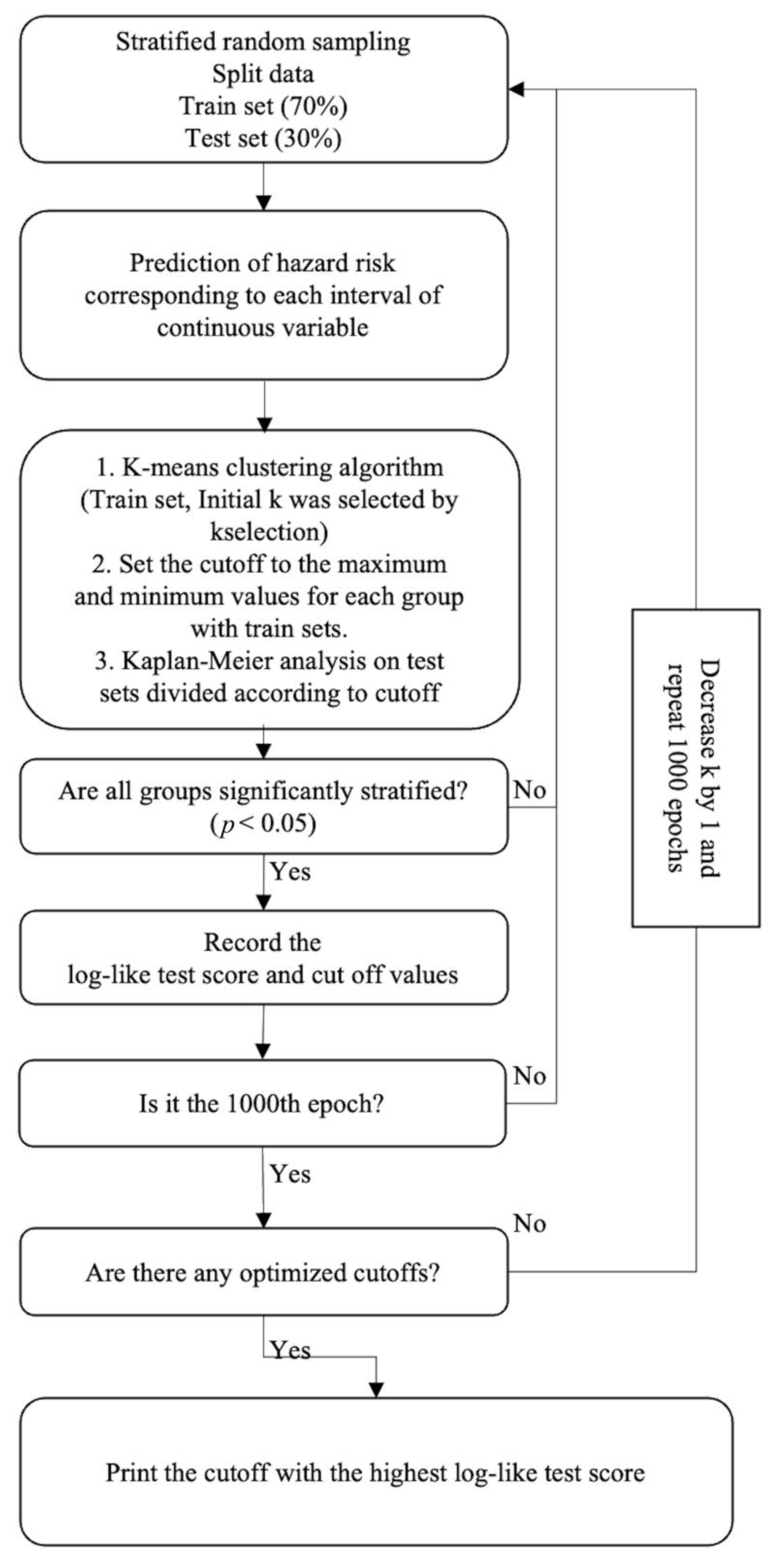
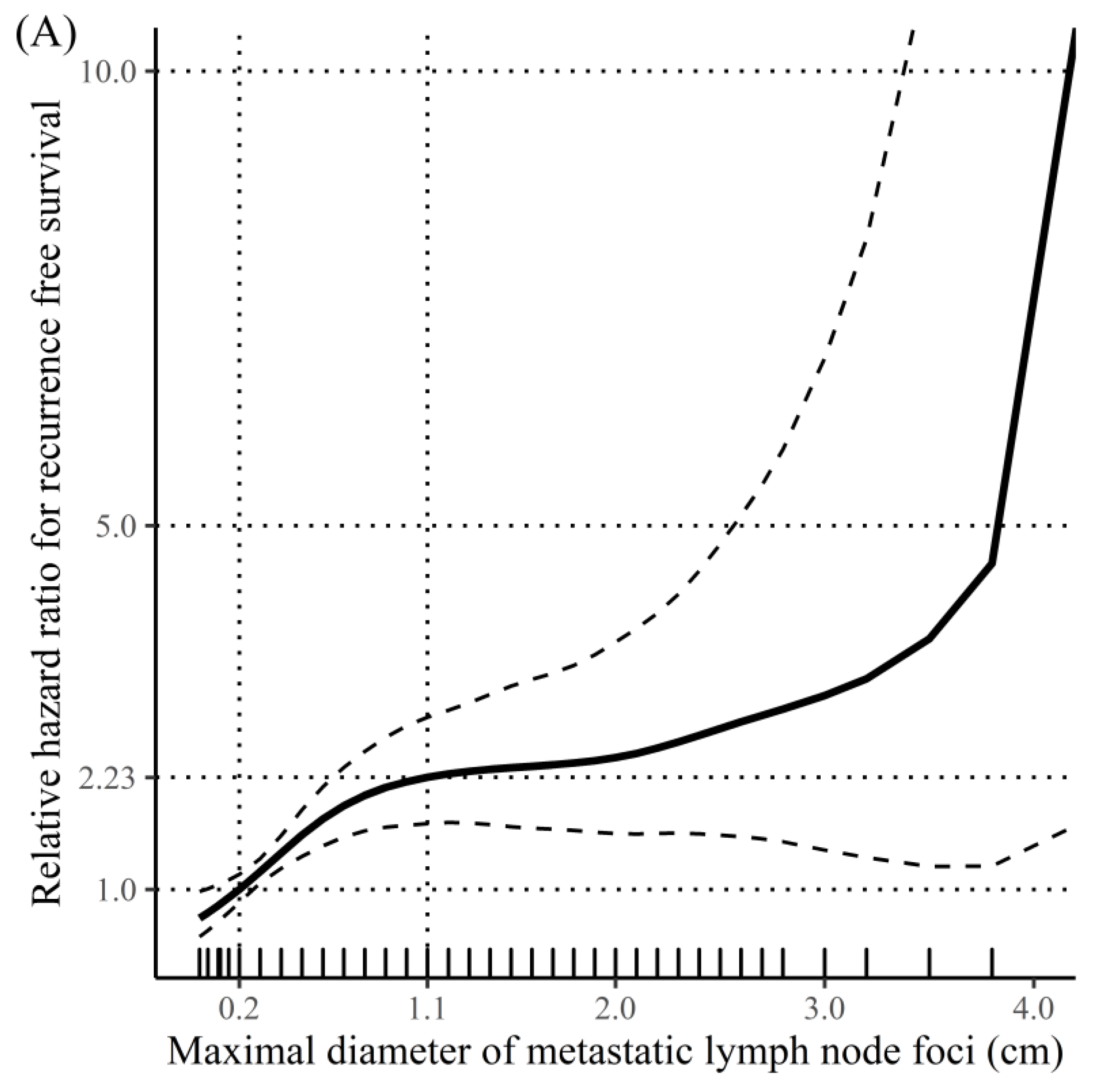

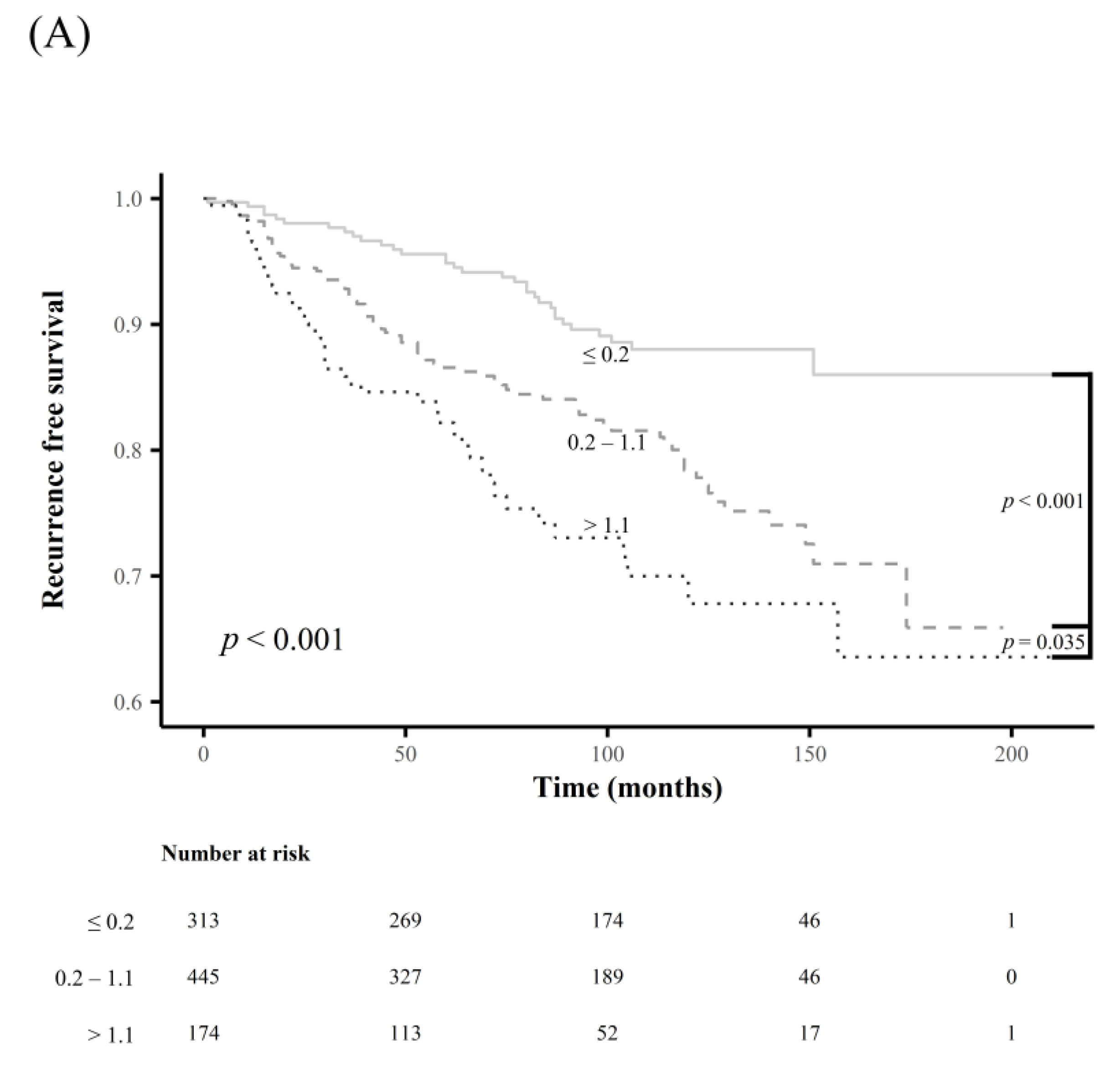
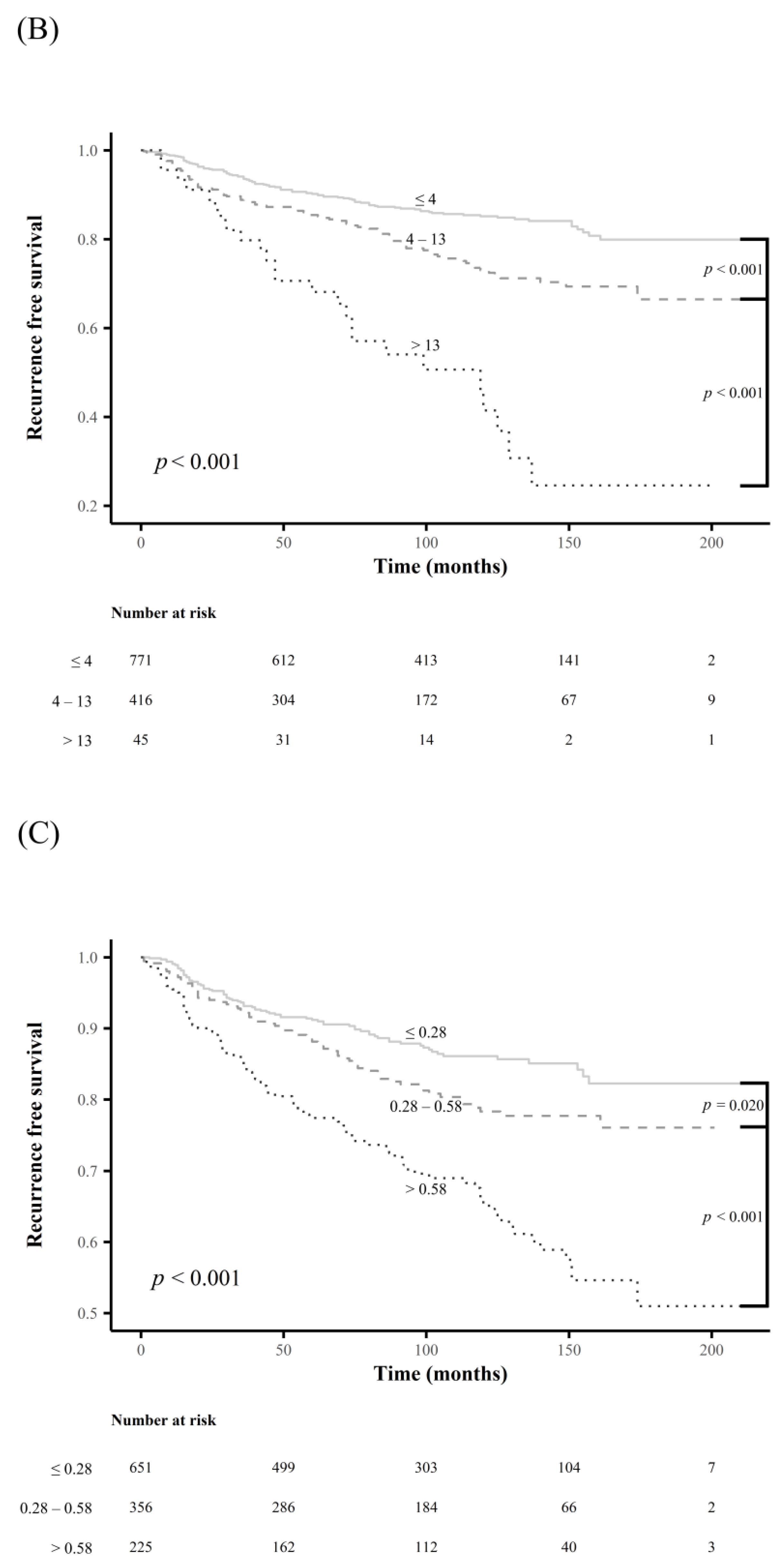
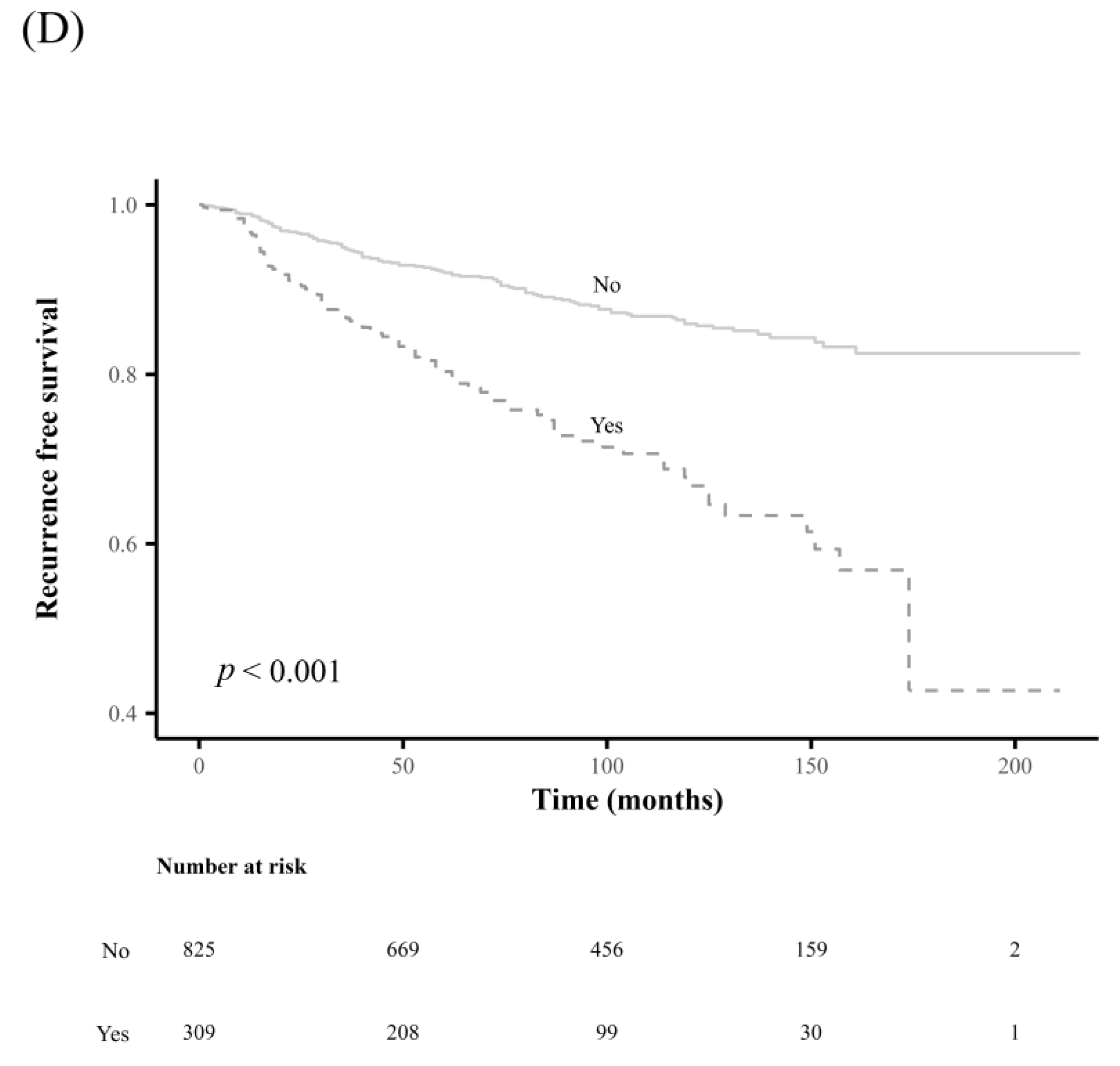

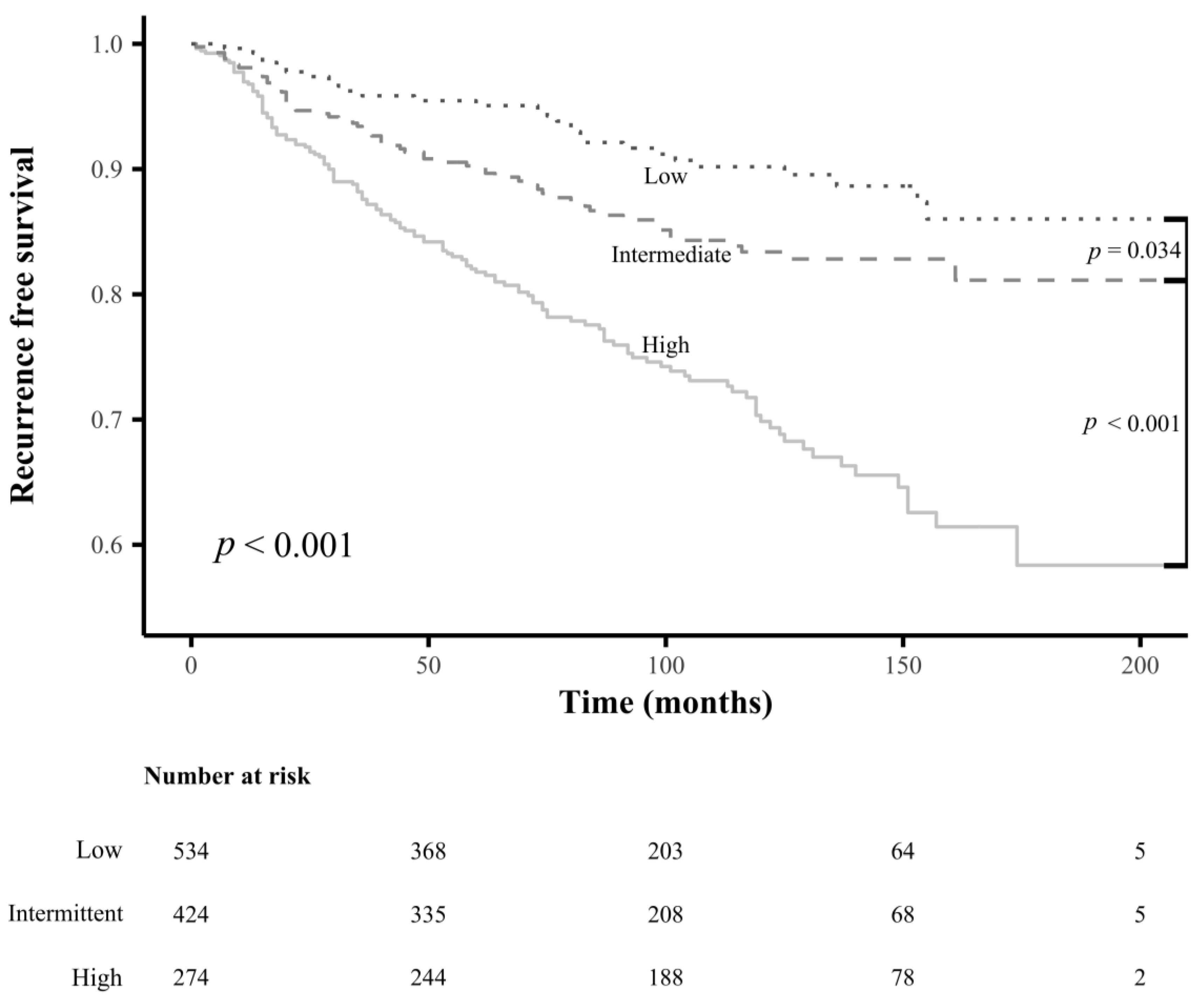
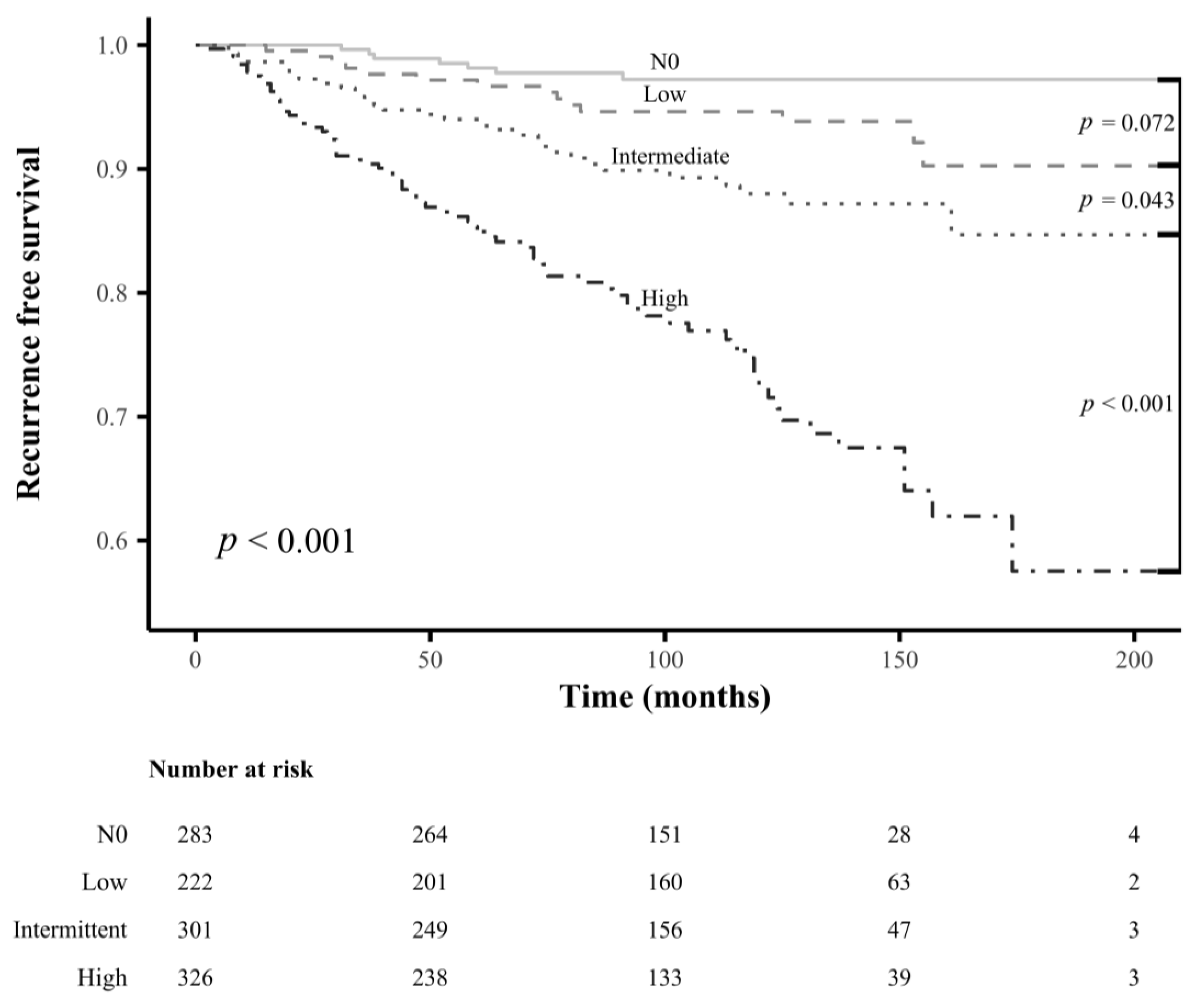
| Characteristics | All a | NED a | Recurrence a | p |
|---|---|---|---|---|
| (n = 1232) | (n = 1007) | (n = 225) | ||
| Age, years, mean ± SD | 44.7 ± 12.9 | 44.6 ± 12.2 | 45.3 ± 15.5 | 0.781 |
| Sex | <0.001 | |||
| Female | 1015 (82.4) | 849 (84.3) | 166 (73.8) | |
| Male | 217 (17.6) | 158 (15.7) | 59 (26.2) | |
| Primary tumor size, cm | 2.0 ±1.2 | 1.8 ±1.1 | 2.5 ±1.5 | <0.001 |
| Multifocality | <0.001 | |||
| No | 684 (55.5) | 584 (58.0) | 100 (44.4) | |
| Yes | 548 (44.5) | 423 (42.0) | 125 (55.6) | |
| Bilaterality | 0.010 | |||
| No | 842 (68.3) | 705 (70.0) | 137 (60.9) | |
| Yes | 390 (31.7) | 302 (30.0) | 88 (39.1) | |
| Microscopic extrathyroidal extension | <0.001 | |||
| No | 336 (27.3) | 299 (29.7) | 37 (16.4) | |
| Yes | 896 (72.7) | 708 (70.3) | 188 (83.6) | |
| Lymphatic invasion | 0.015 | |||
| No | 989 (80.3) | 822 (81.6) | 167 (74.2) | |
| Yes | 243 (19.7) | 185 (18.4) | 58 (25.8) | |
| Vascular invasion | 0.008 | |||
| No | 1126 (91.4) | 931 (92.5) | 195 (86.7) | |
| Yes | 106 (8.6) | 76 (7.5) | 30 (13.3) | |
| N classification | 0.119 | |||
| N1a | 776 (63.0) | 645 (64.1) | 131 (58.2) | |
| N1b | 456 (37.0) | 362 (35.9) | 94 (41.8) | |
| Extent of LN dissection | 0.022 | |||
| Ipsilateral CCND | 543 (44.1) | 463 (46.0) | 80 (35.6) | |
| Bilateral CCND | 233 (18.9) | 182 (18.1) | 51 (22.7) | |
| Ipsilateral mRND | 299 (24.3) | 242 (24.0) | 57 (25.3) | |
| Bilateral mRND | 157 (12.7) | 120 (11.9) | 37 (16.4) | |
| RAI activity, MBq | <0.001 | |||
| 1110 | 51 (4.1) | 46 (4.6) | 5 (2.2) | |
| 2960 | 282 (22.9) | 246 (24.4) | 36 (16.0) | |
| 3700 | 390 (31.7) | 328 (32.6) | 62 (27.6) | |
| 5550 | 509 (41.3) | 387 (38.4) | 122 (54.2) | |
| Extranodal extension | <0.001 | |||
| No | 923 (74.9) | 782 (77.7) | 141 (62.7) | |
| Yes | 309 (25.1) | 225 (22.3) | 84 (37.3) | |
| Maximal diameter of metastatic LN foci, cm | 0.7 ± 0.7 | 0.6 ± 0.6 | 0.8 ± 0.8 | <0.001 |
| Number of retrieved LN, mean ± SD | 17.5 ± 13.4 | 17.5 ± 13.2 | 17.7 ± 14.0 | 0.783 |
| Number of metastatic LN, mean ± SD | 4.5 ±4.0 | 4.1 ±3.6 | 6.4 ±5.3 | <0.001 |
| Metastatic LN ratio, mean ± SD | 0.3 ±0.3 | 0.3 ±0.2 | 0.5 ±0.3 | <0.001 |
| Factors | Univariate | p | Multivariate | p |
|---|---|---|---|---|
| Age | 1.01 (1.00–1.02) | 0.172 | 1.01 (1.00–1.02) | 0.086 |
| Sex | 0.017 | |||
| Female | Reference | Reference | ||
| Male | 1.97 (1.38–2.82) | <0.001 | 1.57 (1.08–2.28) | |
| Primary tumor size | 1.40 (1.27–1.54) | <0.001 | 1.27 (1.15–1.41) | <0.001 |
| Multifocality | 1.58 (1.15–2.17) | 0.004 | 1.81 (1.16–2.82) | 0.009 |
| Bilaterality | 1.42 (1.03–1.96) | 0.034 | 0.81 (0.51–1.29) | 0.373 |
| Microscopic extrathyroidal extension | 1.70 (1.14–2.55) | 0.010 | 1.21 (0.79–1.84) | 0.381 |
| Lymphatic invasion | 1.62 (1.15–2.27) | 0.005 | 1.01 (0.65–1.58) | 0.953 |
| Vascular invasion | 2.01 (1.28–3.15) | 0.003 | 1.39 (0.77–2.53) | 0.275 |
| N classification | 0.521 | |||
| N1a | Reference | Reference | ||
| N1b | 1.38 (0.99–1.93) | 0.058 | 1.19 (0.70–2.02) | |
| Extranodal extension | 2.91 (2.12–3.99) | <0.001 | 1.93 (1.33–2.81) | <0.001 |
| Maximal diameter of metastatic LN foci | 1.63 (1.34–1.97) | <0.001 | 1.36 (1.03–1.79) | 0.029 |
| ≤0.2 | Reference | Reference | ||
| >0.2 and ≤1.1 | 2.14 (1.42–3.22) | <0.001 | 1.52 (0.97–2.37) | 0.068 |
| >1.1 | 3.19 (2.01–5.07) | <0.001 | 2.16 (1.21–3.87) | 0.010 |
| Number of retrieved LN a | 1.00 (0.99–1.02) | 0.477 | 0.97 (0.95–0.99) | 0.003 |
| Number of metastatic LN a | 1.08 (1.05–1.11) | <0.001 | 1.06 (1.02–1.11) | 0.003 |
| ≤4 | Reference | Reference | ||
| >4 and ≤13 | 1.70 (1.22–2.38) | 0.002 | 1.21 (0.82–1.77) | 0.330 |
| >13 | 4.49 (2.68–7.53) | <0.001 | 3.41 (1.67–6.98) | <0.001 |
| Metastatic LN ratioa | 4.26 (2.55–7.13) | <0.001 | 3.28 (1.54–3.94) | <0.001 |
| ≤0.28 | Reference | Reference | ||
| >0.28 and ≤0.58 | 1.33 (0.89–2.00) | 0.161 | 1.21 (0.78–1.87) | 0.394 |
| >0.58 | 2.89 (2.01–4.17) | <0.001 | 2.46 (1.54–3.94) | <0.001 |
| Low | Intermediate | High | |
|---|---|---|---|
| Extranodal extension | absence | - | presence |
| or | or | or | |
| Maximal diameter of metastatic LN foci, cm | ≤0.2 | >0.2 and ≤1.1 | >1.1 |
| or | or | or | |
| Number of metastatic LN | ≤4 | >4 and ≤13 | >13 |
| or | or | or | |
| Metastatic LN ratio | ≤0.28 | >0.28 and ≤0.58 | >0.58 |
| Characteristics | All a | Pathologic N0 a | Pathologic N1 a | p |
|---|---|---|---|---|
| (n = 1515) | (n = 283) | (n = 1232) | ||
| Age, years, mean ± SD | 34.3 ± 12.7 | 36.9 ± 12.0 | 33.7 ± 12.8 | <0.001 |
| Sex | 0.019 | |||
| Female | 1265 (83.5) | 250 (88.3) | 1015 (82.4) | |
| Male | 250 (16.5) | 33 (11.7) | 217 (17.6) | |
| Primary tumor size, cm | 1.9 ± 1.2 | 1.4 ± 1.0 | 2.0 ± 1.2 | <0.001 |
| Multifocality | 0.002 | |||
| No | 871 (57.5) | 187 (66.1) | 684 (55.5) | |
| Yes | 644 (42.5) | 96 (33.9) | 548 (44.5) | |
| Bilaterality | 0.165 | |||
| No | 1048 (69.2) | 206 (72.8) | 842 (68.3) | |
| Yes | 467 (30.8) | 77 (27.2) | 390 (31.7) | |
| Microscopic extrathyroidal extension | <0.001 | |||
| No | 485 (32.0) | 149 (52.7) | 336 (27.3) | |
| Yes | 1030 (68.0) | 134 (47.3) | 896 (72.7) | |
| Lymphatic invasion | 0.040 | |||
| No | 1200 (79.2) | 211 (74.6) | 989 (80.3) | |
| Yes | 315 (20.8) | 72 (25.4) | 243 (19.7) | |
| Vascular invasion | <0.001 | |||
| No | 1403 (92.6) | 277 (97.9) | 1126 (91.4) | |
| Yes | 112 (7.4) | 6 (2.1) | 106 (8.6) | |
| Recurrence | 232 (15.3) | 7 (2.5) | 225 (18.3) | <0.001 |
| Locoregional recurrence | 217 (14.3) | 7 (2.5) | 210 (17.0) | <0.001 |
| Distant metastasis | 27 (1.8) | 1 (0.4) | 26 (2.1) | 0.077 |
| Characteristics | All a | pN0 a | Low-Risk pN1 a | Intermediate-Risk pN1 a | High-Risk pN1 a | p |
|---|---|---|---|---|---|---|
| (n = 1132) | (n = 283) | (n = 222) | (n = 301) | (n = 326) | ||
| Age, years, mean ± SD | 35.9 ± 12.3 | 36.9 ± 12.0 | 36.2 ± 10.4 | 35.5 ± 12.4 | 35.0 ± 13.6 | 0.221 |
| Sex | 0.119 | |||||
| Female | 986 (87.1) | 250 (88.3) | 202 (91.0) | 259 (86.0) | 275 (84.4) | |
| Male | 146 (12.9) | 33 (11.7) | 20 (9.0) | 42 (14.0) | 51 (15.6) | |
| Primary tumor size, cm | 1.5 ± 0.9 | 1.4 ± 1.0 | 1.4 ± 0.8 | 1.5 ± 1.0 | 1.5 ± 0.9 | 0.157 |
| Multifocality | 0.249 | |||||
| No | 704 (62.2) | 187 (66.1) | 141 (63.5) | 186 (61.8) | 190 (58.3) | |
| Yes | 428 (37.8) | 96 (33.9) | 81 (36.5) | 115 (38.2) | 136 (41.7) | |
| Bilaterality | 0.958 | |||||
| No | 824 (72.8) | 206 (72.8) | 162 (73.0) | 222 (73.8) | 234 (71.8) | |
| Yes | 308 (27.2) | 77 (27.2) | 60 (27.0) | 79 (26.2) | 92 (28.2) | |
| Microscopic ETE | 0.976 | |||||
| No | 465 (41.1) | 149 (52.7) | 115 (51.8) | 154 (51.2) | 166 (50.9) | |
| Yes | 667 (58.9) | 134 (47.3) | 107 (48.2) | 147 (48.8) | 160 (49.1) | |
| Lymphatic invasion | 0.944 | |||||
| No | 909 (80.3) | 211 (74.6) | 170 (76.6) | 229 (76.1) | 249 (76.4) | |
| Yes | 223 (19.7) | 72 (25.4) | 52 (23.4) | 72 (23.9) | 77 (23.6) | |
| Vascular invasion | 0.134 | |||||
| No | 1107 (97.8) | 277 (97.9) | 221 (99.5) | 291 (96.7) | 318 (97.5) | |
| Yes | 25 (2.2) | 6 (2.1) | 1 (0.5) | 10 (3.3) | 8 (2.5) | |
| Recurrence | ||||||
| Locoregional | 128 (11.3) | 7 (2.5) | 14 (6.3) | 31 (10.3) | 76 (23.3) | 0.000 |
| Distant | 12 (1.1) | 1 (0.4) | 1 (0.5) | 1 (0.3) | 9 (2.8) | 0.010 |
Disclaimer/Publisher’s Note: The statements, opinions and data contained in all publications are solely those of the individual author(s) and contributor(s) and not of MDPI and/or the editor(s). MDPI and/or the editor(s) disclaim responsibility for any injury to people or property resulting from any ideas, methods, instructions or products referred to in the content. |
© 2023 by the authors. Licensee MDPI, Basel, Switzerland. This article is an open access article distributed under the terms and conditions of the Creative Commons Attribution (CC BY) license (https://creativecommons.org/licenses/by/4.0/).
Share and Cite
Jang, S.-W.; Park, J.-H.; Kim, H.-R.; Kwon, H.-J.; Lee, Y.-M.; Hong, S.-J.; Yoon, J.-H. Recurrence Risk Evaluation in Patients with Papillary Thyroid Carcinoma: Multicenter Machine Learning Evaluation of Lymph Node Variables. Cancers 2023, 15, 550. https://doi.org/10.3390/cancers15020550
Jang S-W, Park J-H, Kim H-R, Kwon H-J, Lee Y-M, Hong S-J, Yoon J-H. Recurrence Risk Evaluation in Patients with Papillary Thyroid Carcinoma: Multicenter Machine Learning Evaluation of Lymph Node Variables. Cancers. 2023; 15(2):550. https://doi.org/10.3390/cancers15020550
Chicago/Turabian StyleJang, Sung-Woo, Jae-Hyun Park, Hae-Rim Kim, Hyeong-Ju Kwon, Yu-Mi Lee, Suck-Joon Hong, and Jong-Ho Yoon. 2023. "Recurrence Risk Evaluation in Patients with Papillary Thyroid Carcinoma: Multicenter Machine Learning Evaluation of Lymph Node Variables" Cancers 15, no. 2: 550. https://doi.org/10.3390/cancers15020550
APA StyleJang, S.-W., Park, J.-H., Kim, H.-R., Kwon, H.-J., Lee, Y.-M., Hong, S.-J., & Yoon, J.-H. (2023). Recurrence Risk Evaluation in Patients with Papillary Thyroid Carcinoma: Multicenter Machine Learning Evaluation of Lymph Node Variables. Cancers, 15(2), 550. https://doi.org/10.3390/cancers15020550





